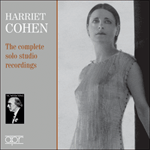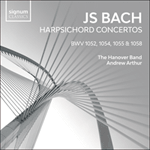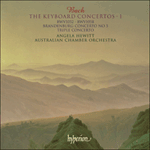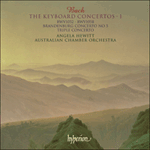
Welcome to Hyperion Records, an independent British classical label devoted to presenting high-quality recordings of music of all styles and from all periods from the twelfth century to the twenty-first.
Hyperion offers both CDs, and downloads in a number of formats. The site is also available in several languages.
Please use the dropdown buttons to set your preferred options, or use the checkbox to accept the defaults.

| Andrew Arthur (harpsichord), The Hanover Band» More |
Certainly the opening tutti, with its unison writing, announces something special, and very different from the other keyboard concertos. This theme reappears throughout, separating the different excursions of the soloist. The most dramatic part of the movement is where the keyboard has a brief moment on its own, taking off over a long sustained pedal note in the bass. The Adagio also begins with a unison tutti – this time a ground bass which is present in every bar, modulating to different keys and sometimes fragmented. The soloist is given an impassioned aria, and engages in dialogue with the violins and violas. The whole is totally reminiscent of Passion music. The third movement is the most brilliant finale of the concertos, not letting up for a moment, and demands the utmost in rhythmic precision and virtuosity.
The first two movements of this concerto appear in the Cantata BWV146, Wir müssen durch viel Trübsal in das Reich Gottes eingehen (‘We must pass through much tribulation to enter God’s kingdom’). Both movements give the solo part to the organ in a slightly less developed form. Amazingly, in what seems like an already very elaborate slow movement, Bach adds a four-part chorus above the keyboard part. The third movement appears as the Sinfonia to Cantata BWV188, Ich habe meine Zuversicht (‘I have my trust in God’). Both of these works were written between 1726 and 1728, so probably pre-date the keyboard concerto. The popularity of this work dates back to Mendelssohn’s performance of it in Leipzig in 1837, and the subsequent publication of the score.
from notes by Angela Hewitt © 2005
Avec son écriture à l’unisson, le tutti d’ouverture annonce à coup sûr quelque chose de spécial, bien différent des autres concertos pour clavier. Ce thème réapparaît tout au long de l’œuvre pour séparer les incursions du soliste. La partie la plus dramatique du mouvement survient lorsque le clavier a un bref moment à lui, en partant sur une longue note de pédale tenue, à la basse. L’Adagio commence, lui aussi, sur un tutti à l’unisson – cette fois, un ground bass présent à chaque mesure, qui module en différentes tonalités et est parfois fragmenté. Quant au soliste, il se voit confier une aria passionnée et entame un dialogue avec les violons et les altos. L’ensemble rappelle en tout point une musique de passion. Le troisième mouvement offre à ce concerto le finale le plus brillant du corpus: il ne faiblit pas un instant, exigeant énormément de précision rythmique et de virtuosité.
Les deux premiers mouvements de ce concerto, qui apparaissent dans la Cantate BWV146, Wir müssen durch viel Trübsal in das Reich Gottes eingehen («Nous devons passer par bien des tourments pour entrer au royaume de Dieu»), confient la partie solo à l’orgue, sous une forme légèrement moins développée. Fait surprenant, un chœur à quatre parties est ajouté par-dessus la partie de clavier, dans ce qui semble un mouvement lent déjà fort élaboré. Le troisième mouvement correspond à la Sinfonia de la Cantate BWV188, Ich habe meine Zuversicht auf den getreuen Gott gericht’t («J’ai placé ma confiance dans le Dieu fidèle»). Ces deux cantates ont été écrites en 1726 et en 1728, et sont donc probablement antérieures au Concerto pour clavier, dont la popularité remonte à l’interprétation que Mendelssohn en donna à Leipzig, en 1837, et à la publication de la partition qui s’ensuivit.
extrait des notes rédigées par Angela Hewitt © 2005
Français: Hypérion
Das Anfangstutti, das im Unisono erklingt, kündigt jedenfalls etwas Besonderes an und unterscheidet sich sehr von den anderen Klavierkonzerten. Das Thema kehrt mehrmals wieder und trennt die verschiedenen Ausflüge des Solisten jeweils voneinander ab. Der dramatischste Moment des Satzes ist derjenige, wenn das Klavier für kurze Zeit allein erklingt und sich über einem langen Orgelpunkt im Bass verausgabt. Das Adagio beginnt ebenfalls mit einem Tutti im Unisono – diesmal ein Basso ostinato, der sich – in verschiedenen Tonarten und zuweilen in fragmentierter Form – durch den gesamten Satz zieht. Der Solist hat eine leidenschaftliche Aria zu spielen und tritt mit den Geigen und Bratschen in einen Dialog ein. Das Ganze erinnert stark an Passionsmusik. Der dritte Satz ist das brillanteste Finale der sieben Konzerte. Es hält nirgends inne und verlangt äußerste rhythmische Präzision und Virtuosität.
Die ersten beiden Sätze dieses Konzerts erscheinen ebenfalls in der Kantate BWV146, Wir müssen durch viel Trübsal in das Reich Gottes eingehen. Bei beiden übernimmt die Orgel den Solopart in etwas schlichterer Form. Dem schon reich verzierten langsamen Satz fügt Bach sogar noch einen vierstimmigen Chorsatz oberhalb des Orgelparts hinzu. Der dritte Satz erscheint als Sinfonia zur Kantate BWV188, Ich habe meine Zuversicht. Beide Kantaten entstanden zwischen 1726 und 1728, daher wahrscheinlich vor dem Klavierkonzert. Die Popularität des Konzerts geht auf Mendelssohns Aufführung des Werks in Leipzig im Jahre 1837 zurück und auf die darauffolgende Veröffentlichung der Partitur.
aus dem Begleittext von Angela Hewitt © 2005
Deutsch: Viola Scheffel
 Harriet Cohen - The complete solo studio recordings Harriet Cohen - The complete solo studio recordings‘The reader may well divine that I am still half-in-love with Harriet some 40 years after first discovering her: that may well be true. However, I wou ...» More |
 Bach: Harpsichord Concertos Nos 1, 3, 4 & 7 Bach: Harpsichord Concertos Nos 1, 3, 4 & 7The Hanover Band’s players are amongst the finest in their field and the orchestra has built an international reputation for the excellence of its performances and recordings of eighteenth- and nineteenth-century music. On this their first album f ...» More |
 Bach: The Keyboard Concertos, Vol. 1 Bach: The Keyboard Concertos, Vol. 1‘Her [Hewitt's] playing is absolutely captivating: she decorates the solo part with playful, come-hither ornamentation—twirls, flutters, arabesques—an ... ‘Hewitt's Bach is well-known for its expressive restraint, lucid textures and rhythmic grace. These virtues are abundantly present in her thoughtful, ...» More |
 Bach: The Keyboard Concertos, Vol. 1 Bach: The Keyboard Concertos, Vol. 1 |

